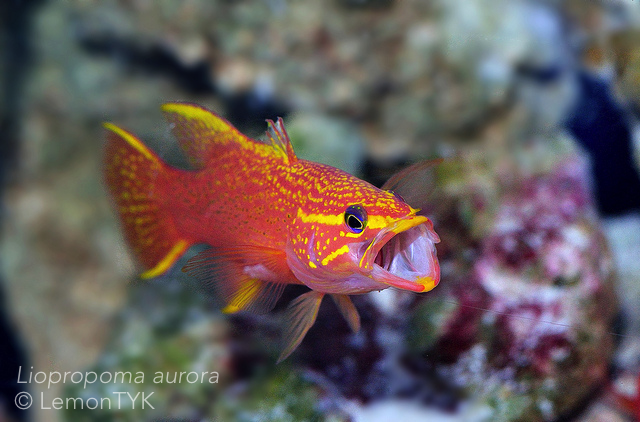Bridging the gap between our previous Osaka recount and the next is this feature on the one and only Liopropoma aurora. Previously in Dr. Shimokobe’s collection, we caught a glimpse of this species being housed in his deepwater set up. Liopropoma is an all time favorite genus around here, and we’ve covered quite a collection of species pretty extensively in the past. Although every piece in Dr. Shimokobe’s collection is something of a marvel, one of the highlights that really left a lasting impression was this incredible show stopping Liopropoma aurora. In this post we’ll learn more about the species, and also take a better look at it in video.
Liopropoma aurora is a Hawaiian endemic that is rarely found much above 100ft. The species attains a maximum size of six inches, placing it in the complex of larger more predatory Liopropoma species that are quite unlike the smaller members. The specific epithet “aurora” was given after the latin word for dawn, which is synonymous with its common name of Sunrise Basslet. Interestingly, Aurora is also known in Roman Mythology as the goddess of dawn, where she flies across the sky every morning signalling the arrival of the sun. Liopropoma aurora is uniformly salmon suffused with a rich orange. A constellation of chromic yellow spots and streaks adorn the dorsum, fin edges and face giving it an almost sun-rise looking quality.

L. aurora is most closely related to L. lunulatum and L. randalli, but differs in coloration and ray counts on the soft dorsal fin. Like most Liopropoma, L. aurora is shy and coy, preferring to stay within the confines of its calcerous catacombs. However this particular specimen, perhaps having been accustomed to captivity for awhile, is exactly the opposite. As it swims in its deepwater habitat, whatever little light available is reflected off the yellow accents, especially on the almost aboriginal tribal like markings on its forehead. The yellow is similar in tone to the beautiful lead iodide, which should ring a bell if you’re familiar with the classic experiment of precipitate formation between the soluble solutions of potassium iodide and lead nitrate. Tertiary level inorganic chemistry 101.

Despite looking like an absolute queen, this specimen did not have it easy since the beginning. There is hardly ever any smooth sailing when it comes to deepwater fish, especially members in this genus for some reason. Post collection DCS often shows up in the coming weeks or months manifesting in the form of a bloated swim bladder, resulting in positive buoyancy. The photo above shows the same Liopropoma back in 2012 when it was first obtained by Dr. Shimokobe. It’s pretty evident in the photo the severe state of positive buoyancy this fish was suffering from, so much so that it could not even right itself up.
Back then Digiman was visiting Osaka and he managed to get some photos of the needling procedure to relief the fish of excess gas build up. A hypodermic needle is commonly used to bleed out excess air, returning the fish to a state of neutral buoyancy. This is often done in situ during collection, just before bringing it up to surface so as to avoid the over expansion of the bladder as it experiences a change in pressure from the deep to the surface. However a relapse often occurs in such deepwater fish, and we’re not sure why, but it could be due to physical trauma of the bladder disallowing regulation of buoyancy. In such cases, manual decompression using the lancing technique has to be done, as seen here, to right the fish back into neutral buoyancy.
The video above shows the same fish minutes after needling. It’s very clear how much difference a little bit of air can make, and once the excess is bled out, the fish is able to swim and stay neutrally buoyant once more. Take note that this video and photo of the needling procedure occurred back in 2012. Today the fish is vibrant, healthy and free from DCS relapse.

As mentioned before it’s rather unusual how this L. aurora is no stranger to camera flashes and human curiosity. Not once did we see it hiding or exhibiting cautious behaviour. Like many basslets in the family Serranidae, Liopropoma is capable of exhibiting defensive behaviour by gaping their mouth when feeling threatened or confronted. The featured image of this post shows not a a yawning fish, but rather a fish in its defensive posture. Because of its size, this species is best kept with other fish of similar stature. Small gobies or cardinals make only for fodder, and should not be kept together. In fact, personal experience with a two inch Liopropoma multilineatum and a group of Apogon parvulus resulted in rather traumatic memories of the former stalking and striking at the group like a jungle feline. Seeing as L. aurora is many times the size of L. multilineatum, small fish is a definite no go.

In captivity, L. aurora is exceedingly rare. Only a handful have ever been collected from deepwater Hawaii, and even fewer specimens are kept alive. This particular species seems to be extra susceptible to DCS relapse and will perish if needling is not provided to correct the malady. Dr. Shimokobe is perhaps the only one currently with a living breathing specimen in his home aquarium. We will end this post with a HD video below. Watch in 1080p to really see intricate spotting on the fish.




